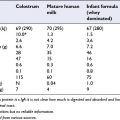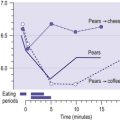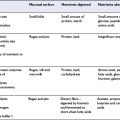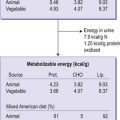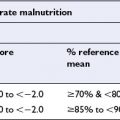CHAPTER 5 Minor Dietary Components
By the end of this chapter you should be able to:
• identify good food sources of water-soluble vitamins, fat-soluble vitamins, minerals and trace elements
• summarize the absorption and transport of each
• summarize the main metabolic functions of each
• describe the main effects of deficiency and excess of each
• understand the methods of assessment of status
• appreciate the metabolic interactions between different micronutrients
5.1 INTRODUCTION
The term ‘minor dietary components’ in this book refers to vitamins, minerals, trace elements and phytochemicals. The term reflects the fact that the amounts of these nutrients present in typical diets range from micrograms, as for vitamin B12, to grams, as for calcium, in contrast to the very much higher dietary intakes of fats, carbohydrate and protein. This is a diverse group of dietary components, with wide-ranging functions. For some, such as iron, deficiency states are often encountered in human populations, even in high-income countries, whereas for other nutrients, such as sodium, dietary deficiency is uncommon. Of course, inadequate dietary intake will not be the sole determinant of poor nutritional status; many other factors, such as genotype, and lifestyle factors such as physical activity, the use of medication, alcohol consumption and smoking habits, can interact with diet to influence nutritional status. Furthermore, dietary deficiencies are not always encountered as single nutrient deficiencies, and certain dietary patterns are associated with multiple nutrient deficiencies. This chapter considers, in a brief way, the main features of metabolism, effects of deficiency and excess, dietary sources of each nutrient and daily requirements.
5.2 WATER-SOLUBLE VITAMINS
Vitamin B1– thiamin
Assessment of thiamin status and dietary requirements
Thiamin requirements depend largely on carbohydrate intake. In practice, requirements are calculated on the basis of total energy intake. For diets that are lower in fat, and hence higher in carbohydrate and protein, thiamin requirements will be higher. Depletion/repletion studies show that an intake of 0.3 mg/1000 kcal is required for a normal transketolase activation coefficient and this is the basis of the current recommended intakes.
Riboflavin – vitamin B2
Assessment of riboflavin status and dietary requirements
On the basis of depletion/repletion studies, the minimum adult requirement is 0.5–0.8 mg/day. Because of the central role of flavin coenzymes in energy yielding metabolism, reference intakes are sometimes calculated on the basis of energy intake: 0.6–0.8 mg/1000 kcal (0.14–0.19 mg/MJ).
Niacin
Forms in foods and good food sources of niacin
Meat and fish are good sources of preformed niacin and nuts and some fruits and vegetables provide significant amounts. Most of the niacin in cereals is biologically unavailable. Because synthesis of niacin from tryptophan is more important than dietary preformed niacin, foods that are good sources of protein are also good sources of niacin. Total niacin intakes are calculated as mg niacin equivalents: the sum of preformed niacin plus 1/60 of tryptophan (the average equivalence of dietary tryptophan and niacin).
Vitamin B6
Metabolic functions of vitamin B6
Pyridoxal phosphate is involved in many reactions of amino acid metabolism, is a cofactor for glycogen mobilization, and plays a role in lipid metabolism and in steroid hormone action. Vitamin B6-dependent enzymes catalyse several types of reactions involving amino acids including transamination, which is central both to the utilization of amino acid carbon skeletons for gluconeogenesis or ketogenesis and also the synthesis of non-essential amino acids, and decarboxylation, to form a variety of biologically active amines such as the neurotransmitter serotonin (see chapter 4).
Effects of vitamin B6 deficiency and excess
Vitamin B6 is widely distributed in foods and is synthesized by intestinal flora so clinical deficiency is rare, although biochemical deficiency is reported in 10–20% of the population of developed countries. Although clinical and physiological effects of vitamin B6 deficiency in animals have been well-characterized there is relatively little documented about clinical deficiency in humans, except for neurological abnormalities in acute deficiency. Studies suggest that low vitamin B6 status increases the risk of cardiovascular disease, probably independent of an associated elevation of plasma homocysteine.
Folates
Folic acid derivatives function in the transfer of one-carbon fragments in a variety of reactions. The term folate includes a number of compounds with a common ring structure to which one or more glutamic acid residues are attached. The compounds exist in two states of oxidation. In the reduced state the attachment of various one-carbon groups forms the biologically active coenzymes. The term folic acid strictly only refers to the simplest, oxidized form, carrying a single glutamic acid residue.
Metabolic functions of folate
Folate is central to reactions involving the transfer of one-carbon units, in biosynthetic and catabolic processes. It plays an important role in the synthesis of purines and pyrimidines for nucleic acid synthesis, and acts as a methyl group donor to various substrates, including DNA. There is evidence that the role for folate in DNA methylation is important for gene expression and may influence carcinogenesis. Folate plays a key role in the regulation of concentrations of the amino acid homocysteine in cells and in the plasma, through its conversion to methionine by methylation. This is important because raised plasma homocysteine is considered to be a risk factor for cardiovascular disease. Certainly increasing folate intake will reduce plasma homocysteine levels, but the role for homocysteine in determining cardiovascular disease risk is still uncertain. A commonly occurring polymorphism (see chapter 11) in the gene expressing methylene tetrahydrofolate reductase, which generates the methyl group essential for methylation of homocysteine, is associated with a reduced concentration of red blood cell and plasma folate and an increased plasma homocysteine concentration, particularly in people with low folate intake.
Folate deficiency and neural tube defects
The neural tube, which runs from the brain to the lower end of the spinal cord, normally closes in embryonic development in the third and fourth weeks after fertilization. A failure of this process leads to a range of severe fetal malformations collectively known as neural tube defects. There is evidence that low folate status in women increases the risk of neural tube defects in their offspring and that supplements of 400 μg/day of folic acid, begun before conception, significantly reduce risk. Women who are planning a pregnancy are advised to take folic acid supplements.
Assessment of folate status and daily requirements
Because of the problems of determining the availability of the mixed folates in foods, reference intakes allow a wide margin of safety. Current reference daily intakes for the UK population range from 50 μg in infants to 200 μg in adults, with an increment of 100 μg during pregnancy. Dietary reference values for Europe and USA are higher, rising to 400 μg and 600 μg respectively, in pregnancy.
Vitamin B12
Effects of deficiency and excess of vitamin B12
There is no evidence of adverse effects of high oral doses of vitamin B12.
Assessment of vitamin B12 status and dietary requirements
Vitamin B12 status is usually determined by measuring plasma total vitamin B12, although there is general agreement that it does not always adequately reflect tissue depletion, especially in people with impaired renal function. Plasma holotranscobalamin (transcobalamin saturated with vitamin B12), is currently under scrutiny as a marker of vitamin B12 status. Methylmalonic acid accumulates in cells during vitamin B12 depletion because of a block in a metabolic pathway, and plasma and urinary concentrations of this compound offer potential as functional markers of deficiency.
Vitamin C (ascorbic acid)
Forms in foods and good food sources
Ascorbic acid is the physiologically important form of the vitamin. It can oxidize to dehydroascorbic acid but this retains biological activity because it can be reduced to ascorbic acid. Fruits and vegetables are rich sources of ascorbate; blackcurrants and guava provide about five times the reference intake in a single serving, and potatoes are an important source in many countries.
